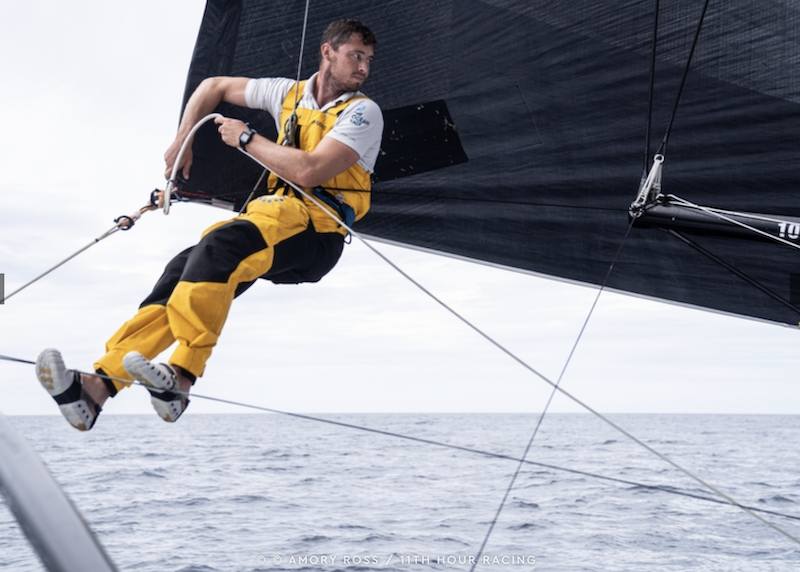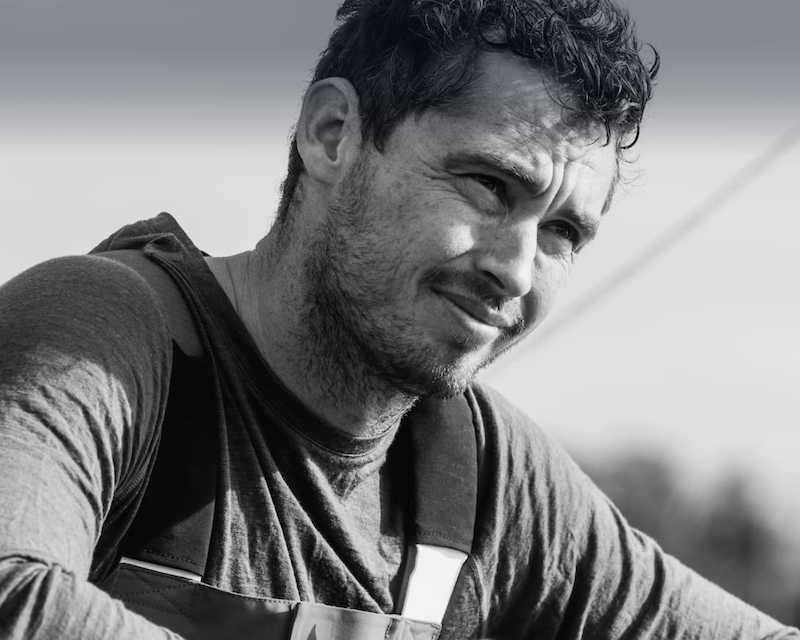BOUTTELL ON THE BOW
JACK BOUTTELL is one of the most in-demand bowmen in the professional racing world. In 2018/19 he was part of the Volvo Ocean Race winning crew on board Dongfeng Racing Team, and he was also a key member of 11th Hour Racing Team who won The Ocean Race in 2023. He has also competed in a number of editions of the Solitaire du Figaro and has raced on the giant trimarans like Spindrift Racing for its round-the-world assault on the Jules Verne Trophy.

INTRO
There are a number of roles on a race boat where you can just turn up with your kit bag, jump on board and start racing. At least that’s what Jack Bouttell reckons. But this approach doesn’t work for doing the bow, says the half-Brit/half-Aussie, who claims that the success of his job really comes down to preparation more than anything else. This applies especially for inshore bowmen about to go offshore for a big race. If you try to wing it, and make it up as you go along, you’ll come unstuck. A good bowman will find out as much as he can about the boat and the systems on board, even before he has arrived at the marina. Training time is critical for planning and refining processes, especially working up a system of communications between the crew, as Bouttell found on the multinational, multilingual Dongfeng crew and on Spindrift where everything is spoken in French. Here are Bouttell’s five best tips for working the bow offshore.
1. PREPARATION, PREPARATION, PREPARATION!
Learn the boat inside out. Ideally you have the time to do this, but if it’s all last-minute you need to be even more efficient with your time. Mark everything - key positions on sheets, halyards, the deck, whatever makes the job repeatable. It may sound basic, but getting the basics right helps you focus on the more complicated parts of the job. If you can talk to people with experience of sailing the boat, ask them. Don’t be shy, and don’t be too proud to ask. Much better to learn from others’ experience than trying to reinvent the wheel.
The more you can get your systems organised in daylight, the simpler things become at night. One of the easiest things to mess up at night or one of the hardest things to recover from is halyard storage; it's normally the easiest one to get wrong and it's normally the hardest one to put right again. On a 30 footer maybe you can see the top of the rig with a head torch and there's perhaps only a couple of halyards and you can sort it out. But, when the boat gets a bit bigger there are more halyards and more complications and locks. Even if you've checked the halyards a hundred times, at sunset check them again, just really make sure that everything’s really well sorted. Make sure you are the only one that touches halyards and stores halyards - or else that you have a mid bowman who knows the exact same system as you.
If you need to go up the rig to run some checks, do it in the marina or if you’re already racing and it’s blowing 30 knots but it’s forecast for no wind the next day, then wait until the next day to go up the rig. Sometimes you have no choice but to go aloft at sea, so make sure you’ve worked out your hand holds in advance.
2. GET THE WEATHER FORECAST
Talk to the navigator or whoever is most clued up about the weather forecast for the race, so that you know what conditions to expect at which point in the race. That way you can make sure the headsails are stacked in the best order for what you’re expecting to go up the rig first. Make sure you can easily identify the sails because these days often every single sail comes in the same bag. It's the same shape, the same length, especially on IRC boats when you've got five jibs, five kites, etc. So have all the bags and sails properly marked for easy identification. If you've looked at the forecast and you know that the first day there is no wind, then you can probably put the heavy job on the bottom. But if you know the first day is going to be 30 knots, then put the light wind jib on the bottom.
3. TAKE A SPARE SET OF THERMALS
Making the transition from inshore bowman to offshore bowman, one of the hardest things to get right is your clothing. If you get wet when you’re inshore racing, you’re only wet for a few hours before you get back ashore and can warm up in a hot shower. That’s a luxury you can’t afford offshore, which is why I have spent a lot of time working out a good clothing system, making sure my gaiters fit my boots and that all the neck and wrists seals are the right size. I always take a second set of thermals because if you get wet on day one than you’re wet until the finish. Practise getting dressed quickly so that if conditions suddenly change for the worst, you’ve got your system down, and you’re ready for that moment of action.
4. SORT OUT YOUR COMMS SYSTEM
I’m not a big talker, so I have worked out a good system of hand signals. These are vital because when you can't verbally communicate, maybe because it’s too windy and noisy, you can still visually communicate. Obviously at night that doesn't work quite as well, although you can still shine your head torch on to your hand. Sit down with the key people that you’re going to be working with the most - maybe the skipper, the navigator and the crew boss - and make sure you’ve agreed a system of three or four key signals; these could be: “Good to go!”, “Hold!” and “Stop!”. Just make sure have a clear system where if someone asks you something, you always reply. And make sure you always get a reply back because you can’t afford for there to be doubt or ambiguity. Agree the word you’re going to use, eg. “Copy!” or “Got it!”. Headsets can be useful on bigger boats but they don’t always like salt water and batteries can run down, so still make sure you have a visual signal system in place as a back-up.
5. BE SAFE AND CLIP ON AS MUCH AS YOU CAN
Obviously you want to be able to be clipped on for as much of the time as possible. This is where pre-race preparation comes in again, especially when you’re on a boat for the first time. See if you can walk from the shroud to the bow without unclipping because I’ve been on a lot of boats where you can’t do that, which puts you at unnecessary risk. Realistically there are some manoeuvres where you can’t be clipped on the whole time, which is not ideal. More than being on the bow, though, the time I feel most vulnerable is when I’m working on the leeward side of the boat because if you slip there’s nothing to catch you. That’s when I’m really careful about being clipped on. If you do go overboard, give yourself the best chance of being rescued. Whenever I go offshore I carry a personal AIS, a knife, a personal EPIRB, a flare and a water die marker. If you drop the marker in the water, it makes a big colourful patch. That's always either in my wet weather gear trousers or if it's hot in a bum bag type thing. This stuff is vital and you must have it on you at all times.

